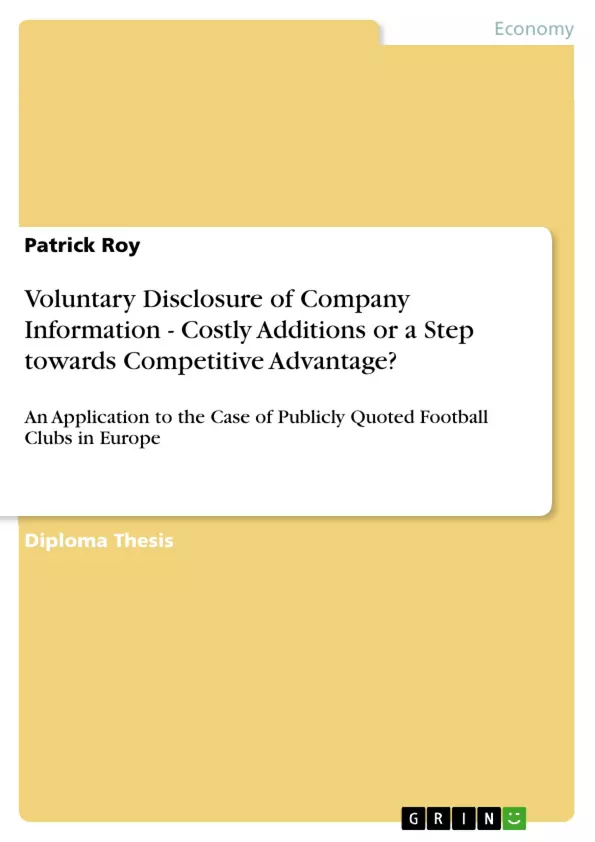In einem ersten Schritt leitet diese Diplomarbeit (European Research Project, ERP) die Notwendigkeit von freiwilliger Unternehmenspublizität in strategischen und nicht-finanziellen Bereichen her. Es wird argumentiert, daß Unternehmen ein integraler Bestandteil einer gemeinsamen Umwelt sind und sich in einer Reihe interdependenter Beziehungen mit dieser befinden. Daher werden sie zunehmend als Interessengemeinschaften verschiedener Anspruchsgruppen gesehen, die nur dann optimal handeln können, wenn die Ansprüche umfassend beachtet und berücksichtigt werden. Dabei sind Informationsansprüche davon abhängig, wie die jeweilige Information zur Verbesserung von Entscheidungsprozessen genutzt werden kann. Dies wiederum wird vom Potential der Information bestimmt, Unsicherheit in den betreffenden Entscheidungsbereichen zu reduzieren. Unsicherheit besteht für externe Entscheidungsträger vor allem in den Bereichen, in die herkömmliche Unternehmensinformationen wenige oder gar keine Einblicke gewähren. Aufgrund der traditionellen, finanzorientierten Auffassung der Publizität gilt dies in besonderem Maße für strategische und andere nicht-finanzielle Aspekte. Entsprechende freiwillige Publizität kann daher Unsicherheit erheblich reduzieren, insbesondere dann, wenn sie im Rahmen von testierten Dokumenten stattfindet. Gängige Finanzberichterstattung und bestehende Pflichtpublizität sind dagegen nicht in der Lage, die Befriedigung der Informationsbedürfnisse der Anspruchsgruppen annähernd zu gewährleisten.
Inhaltsverzeichnis (Table of Contents)
- Introduction
- Problem Area and Objectives of the Work
- Rationale
- Conception of Strategic and Non-financial Voluntary Disclosure, Delimitation and Use of Terms
- Demand for Strategic and Non-financial Voluntary Disclosure
- Function and Role
- Target Groups
- Factors Affecting Demand
- Contents and Relevance of Specific Voluntary Disclosure Areas
- Strategic Disclosure
- Non-Financial Disclosure
- Supply-Side Factors Influencing Voluntary Disclosure Behaviour
- Regulatory Environment as a Supply-Side Factor
- Organisations Relevant to Setting Disclosure Standards
- Legal Requirements
- Potential Opportunities and Disadvantages of Voluntary Disclosure as Supply-Side Factors
- Effects on Capital Markets
- Processing of Information in Capital Markets
- Executives' Assessment of Effects and Resulting Disclosure
- Effects outside Capital Markets
- Management
- Employees
- Competitors
- Customers, Suppliers, Creditors
- Other Possible Benefits
- Common Costs Related to Disclosure
- Significance of Company Characteristics
- Effects on Capital Markets
- Regulatory Environment as a Supply-Side Factor
- Enhancing the Knowledge of Voluntary Disclosure
- Necessity for a Better Understanding of Voluntary Disclosure
- Unresolved Problems and Hypotheses to Examine
- Specific Additional Knowledge to be Contributed
- Determinants and Incentives for Strategic and Non-financial Voluntary Disclosure in Practice
- Research Methodology
- Research Site
- Research Design
- Review of Annual Reports
- Items for Voluntary Disclosure and their Scoring (Dependent Variable)
- Corporate Characteristics (Independent Variables)
- Results of the Review of Annual Reports
- Descriptive Statistics: Company Characteristics and Actual Disclosure by Companies
- Multiple Linear Regression: Company Characteristics and Disclosure Scores
- Interviews with Executives
- Obtaining the Data
- Analysing the Data
- Results of the Interviews with Executives
- Influence of Company Characteristics
- Additionally Perceived Incentives and Disincentives
- Process of Decision-Making
- Differences between Strategic and Non-Financial Voluntary Disclosure
- Research Methodology
- Conclusion
- Summary of Results and Interpretation
- Implications
- Critical Assessment of the Research
- Extension
Zielsetzung und Themenschwerpunkte (Objectives and Key Themes)
This research project investigates the complex relationship between voluntary disclosure of company information and competitive advantage in the context of publicly quoted football clubs in Europe. It aims to analyze the factors influencing the demand and supply of such disclosures, evaluate the potential benefits and costs associated with them, and contribute to a better understanding of the determinants and incentives for strategic and non-financial voluntary disclosure practices in this industry.- Voluntary disclosure of company information in the football industry
- Factors influencing the demand and supply of voluntary disclosure
- The role of regulatory environment and capital markets
- Potential benefits and costs of voluntary disclosure for football clubs
- Determinants and incentives for strategic and non-financial voluntary disclosure
Zusammenfassung der Kapitel (Chapter Summaries)
- The introductory chapter establishes the research problem and objectives, outlining the rationale for studying voluntary disclosure in the context of football clubs. It defines key terms and concepts, particularly emphasizing the distinction between strategic and non-financial voluntary disclosure.
- Chapter 2 delves into the demand for strategic and non-financial voluntary disclosure, exploring its function and role, target groups, and the factors influencing this demand. The chapter also examines the specific content and relevance of strategic and non-financial disclosure areas.
- Chapter 3 focuses on the supply-side factors influencing voluntary disclosure behavior. It analyzes the regulatory environment as a key factor, including relevant organizations and legal requirements. The chapter also discusses potential opportunities and disadvantages of voluntary disclosure, considering its effects on capital markets and various stakeholders like management, employees, competitors, customers, and creditors.
- Chapter 4 highlights the need for a better understanding of voluntary disclosure, outlining unresolved problems and hypotheses to be examined. It also identifies specific additional knowledge contributions to be made by the research project.
- Chapter 5 details the research methodology employed, including the research site (publicly quoted football clubs in Europe) and research design. The chapter then presents the results of a review of annual reports, focusing on items for voluntary disclosure and their scoring, as well as company characteristics. Interviews with executives are also discussed, exploring their perspectives on incentives, disincentives, and decision-making processes regarding voluntary disclosure.
Schlüsselwörter (Keywords)
This research explores voluntary disclosure of company information, focusing on strategic and non-financial disclosure in the context of publicly quoted football clubs in Europe. It examines factors influencing demand and supply, including regulatory environment, capital markets, and company characteristics. Key terms include: voluntary disclosure, strategic disclosure, non-financial disclosure, football industry, competitive advantage, incentives, disincentives, decision-making, research methodology, and annual report analysis.- Citar trabajo
- Patrick Roy (Autor), 2000, Voluntary Disclosure of Company Information - Costly Additions or a Step towards Competitive Advantage? , Múnich, GRIN Verlag, https://www.grin.com/document/185698



